| Order-7 dodecahedral honeycomb | |
|---|---|
| Type | Regular honeycomb |
| Schläfli symbols | {5,3,7} |
| Coxeter diagrams | |
| Cells | {5,3} |
| Faces | {5} |
| Edge figure | {7} |
| Vertex figure | {3,7}
|
| Dual | {7,3,5} |
| Coxeter group | [5,3,7] |
| Properties | Regular |
In the geometry of hyperbolic 3-space, the order-7 dodecahedral honeycomb is a regular space-filling tessellation (or honeycomb).
YouTube Encyclopedic
-
1/5Views:7323 3083563 623736
-
{5,3,infinity} Honeycomb in H^3
-
6. Natural Honeycombs: Wood
-
It's Sacred Geometry at all scales thank God!
-
Bridges 2018 talk - Visualizing hyperbolic honeycombs
-
Metatron's Cube Distorts Phi Ratio Forms: The Fix - JUST ADD PHI - Behold What Can Unfold
Transcription
Geometry
With Schläfli symbol {5,3,7}, it has seven dodecahedra {5,3} around each edge. All vertices are ultra-ideal (existing beyond the ideal boundary) with infinitely many dodecahedra existing around each vertex in an order-7 triangular tiling vertex arrangement.
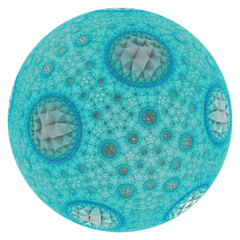 Poincaré disk model Cell-centered |
 Poincaré disk model |
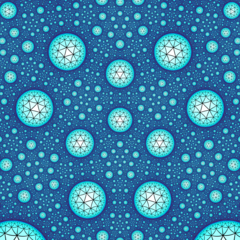 Ideal surface |
Related polytopes and honeycombs
It a part of a sequence of regular polytopes and honeycombs with dodecahedral cells, {5,3,p}.
| {5,3,p} polytopes | |||||||
|---|---|---|---|---|---|---|---|
| Space | S3 | H3 | |||||
| Form | Finite | Compact | Paracompact | Noncompact | |||
| Name | {5,3,3} | {5,3,4} | {5,3,5} | {5,3,6} | {5,3,7} | {5,3,8} | ... {5,3,∞} |
| Image | 
|

|

|

|

|

|

|
| Vertex figure |
{3,3} |
{3,4} |
{3,5} |
{3,6} |
{3,7} |
{3,8} |
{3,∞} |
It a part of a sequence of honeycombs {5,p,7}.
It a part of a sequence of honeycombs {p,3,7}.
| {3,3,7} | {4,3,7} | {5,3,7} | {6,3,7} | {7,3,7} | {8,3,7} | {∞,3,7} |
|---|---|---|---|---|---|---|

|

|

|

|

|

|

|
Order-8 dodecahedral honeycomb
| Order-8 dodecahedral honeycomb | |
|---|---|
| Type | Regular honeycomb |
| Schläfli symbols | {5,3,8} {5,(3,4,3)} |
| Coxeter diagrams | |
| Cells | {5,3} |
| Faces | {5} |
| Edge figure | {8} |
| Vertex figure | {3,8}, {(3,4,3)} 
|
| Dual | {8,3,5} |
| Coxeter group | [5,3,8] [5,((3,4,3))] |
| Properties | Regular |
In the geometry of hyperbolic 3-space, the order-8 dodecahedral honeycomb a regular space-filling tessellation (or honeycomb). With Schläfli symbol {5,3,8}, it has eight dodecahedra {5,3} around each edge. All vertices are ultra-ideal (existing beyond the ideal boundary) with infinitely many dodecahedra existing around each vertex in an order-8 triangular tiling vertex arrangement.
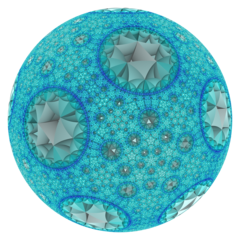 Poincaré disk model Cell-centered |
 Poincaré disk model |
It has a second construction as a uniform honeycomb, Schläfli symbol {5,(3,4,3)}, Coxeter diagram, ![]()
![]()
![]()
![]()
![]()
![]() , with alternating types or colors of dodecahedral cells.
, with alternating types or colors of dodecahedral cells.
Infinite-order dodecahedral honeycomb
| Infinite-order dodecahedral honeycomb | |
|---|---|
| Type | Regular honeycomb |
| Schläfli symbols | {5,3,∞} {5,(3,∞,3)} |
| Coxeter diagrams | |
| Cells | {5,3} |
| Faces | {5} |
| Edge figure | {∞} |
| Vertex figure | {3,∞}, {(3,∞,3)} 
|
| Dual | {∞,3,5} |
| Coxeter group | [5,3,∞] [5,((3,∞,3))] |
| Properties | Regular |
In the geometry of hyperbolic 3-space, the infinite-order dodecahedral honeycomb a regular space-filling tessellation (or honeycomb). With Schläfli symbol {5,3,∞}. It has infinitely many dodecahedra {5,3} around each edge. All vertices are ultra-ideal (existing beyond the ideal boundary) with infinitely many dodecahedra existing around each vertex in an infinite-order triangular tiling vertex arrangement.
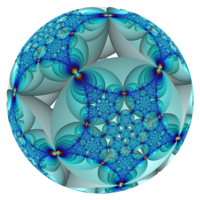 Poincaré disk model Cell-centered |
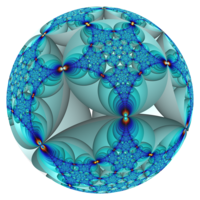 Poincaré disk model |
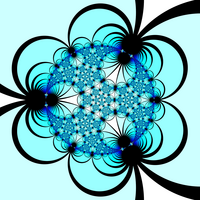 Ideal surface |
It has a second construction as a uniform honeycomb, Schläfli symbol {5,(3,∞,3)}, Coxeter diagram, ![]()
![]()
![]()
![]()
![]()
![]() , with alternating types or colors of dodecahedral cells.
, with alternating types or colors of dodecahedral cells.
See also
- Convex uniform honeycombs in hyperbolic space
- List of regular polytopes
- Infinite-order hexagonal tiling honeycomb
References
- Coxeter, Regular Polytopes, 3rd. ed., Dover Publications, 1973. ISBN 0-486-61480-8. (Tables I and II: Regular polytopes and honeycombs, pp. 294–296)
- The Beauty of Geometry: Twelve Essays (1999), Dover Publications, LCCN 99-35678, ISBN 0-486-40919-8 (Chapter 10, Regular Honeycombs in Hyperbolic Space) Table III
- Jeffrey R. Weeks The Shape of Space, 2nd edition ISBN 0-8247-0709-5 (Chapters 16–17: Geometries on Three-manifolds I, II)
- George Maxwell, Sphere Packings and Hyperbolic Reflection Groups, JOURNAL OF ALGEBRA 79,78-97 (1982) [1]
- Hao Chen, Jean-Philippe Labbé, Lorentzian Coxeter groups and Boyd-Maxwell ball packings, (2013)[2]
- Visualizing Hyperbolic Honeycombs arXiv:1511.02851 Roice Nelson, Henry Segerman (2015)
External links
- John Baez, Visual insights: {7,3,3} Honeycomb (2014/08/01) {7,3,3} Honeycomb Meets Plane at Infinity (2014/08/14)
- Danny Calegari, Kleinian, a tool for visualizing Kleinian groups, Geometry and the Imagination 4 March 2014. [3]
- {5,3,∞} Honeycomb in H^3 YouTube rotation of Poincare sphere
